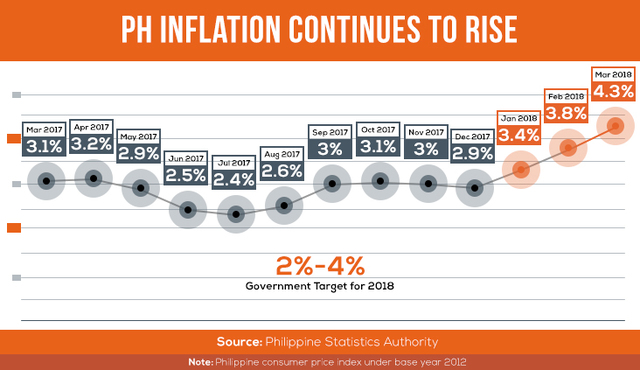Media’s Wider Lens: Reports on the Pain of Inflation

Screengrab from Rappler.com.
ADDRESSING PUBLIC concerns amid the continued rise of the price of most goods and commodities, the Department of Finance (DOF) reassured the public that it will be manageable thanks to the Tax Reform for Acceleration and Inclusion (TRAIN) law.
 The inflation rate hit 4.5 percent in April from 4.3 in March, limiting the first quarter economic growth to 6.8 percent, with the agriculture sector being a major laggard among the other sectors of the economy.
The inflation rate hit 4.5 percent in April from 4.3 in March, limiting the first quarter economic growth to 6.8 percent, with the agriculture sector being a major laggard among the other sectors of the economy.
Finance Chief Economist and Undersecretary Gil Beltran said in a press release published on May 18 that the increased spending on infrastructure and social services are made possible now with the aid of the TRAIN Law, specifically to keep inflation in check (“Inflation manageable with TRAIN, says DOF chief economist”).
“The current spike in inflation is only temporary. All these programs we are implementing, which are made possible because of the additional revenues from TRAIN, are meant precisely to prevent prices from rising further in the future,” Beltran said.
Beltran further added that the TRAIN law only contributed 0.4 percent to the total inflation rate and the higher global prices of crude oil and an uptick of rice, corn, tobacco and transportation prices should be blamed for the fast rising inflation.
DOF’s assurance did not indicate the time frame that government sees for the inflationary pressure to ease, to indicate when the public could find some relief from increased cost of living. There is little comfort to be gained when government talks about price stabilization. As everyone knows, the price can stay at the level to which these have risen. Media reports which recorded these assurances without question and gave Beltran an easy pass while failing to give the complete story.
Cheers to ANC’s News Now, Rappler, and Inquirer.net for giving context to the actual impact of rising inflation to different sectors of society.
According to a May 11 report on ANC’s News Now, the national average inflation rate is at 4.5 percent in April but the heat map they projected showed that different regions suffered different circumstances with a lot of southern provinces suffering higher prices.
The Zamboanga peninsula suffered the highest inflation rate of 6.1 percent, 30 percent higher than the national average, while the Autonomous Region of Muslim Mindanao (ARMM) and Central Visayas have a 5.9 and 5.8 percent inflation rate respectively.
News Now also reported that the bottom 30 percent income group suffered a higher inflation rate of 5.3 percent with the price of rice increasing by 4.3 percent in April.
In an article published May 14, Rappler featured the case of Nancy Castro, who has run her own canteen in Project 4, Quezon City for 8 years. “Nancy’s BBQ” earns around P60,000 per month just from selling barbecue, pork and chicken intestines, and budget “silog” meals. But for the past few months, Nancy’s BBQ has been struggling from the sudden surge of market prices caused by the TRAIN law (“The burden of TRAIN law on Filipino mothers”).
Nancy said one crate of 12-ounce Coca-Cola products used to cost around PHP108, but now it costs PHP132. A tank of gas that used to be sold for PHP450 is now at PHP600-650. Even the prices of meat, vegetables, and rice have increased.
Nancy cannot afford to increase the prices of her barbecues and budget meals because the competition is high in her area. She is now contemplating whether or not she should close her business.
Small time business owners are not the only ones affected by the TRAIN law.
In a May 1 article, Inquirer.net reported that the rice farmers’ income dropped by 10 percent due to higher fuel prices brought upon by TRAIN (“Rice farmers’ income down 10% due to TRAIN law”).
According to the report, the Philippine Rice Research Institute (PhilRice) said that fuel cost, which accounts for 30 percent of a farmer’s total production cost, had risen by PHP2,014 per hectare (ha) due to higher petroleum prices, which increases the production cost of pump-dependent farmers by 50 centavos for every kilogram (kg) of palay produced and diminishes their income by 10 percent.
Rice farmers’ fuel cost increased from PHP13,862 per ha to PHP15,876 according to the data from PhilRice.
CMFR already noted in a previous monitor that the media should sustain an inclusive approach to its information gathering and its business and economic stories should reach out to different sectors, and not just the ones who benefit directly from economic growth as it takes some time for the benefits to trickle down (See: “Connecting Coverage of Economic Gains to the Poor”).
As TRAIN moves forward, government should be urged to try to address the impact of inflation as a serious and current public concern. The media has to report on the effects of government policies so the policy makers are made aware that not everyone lives on the positive side of a growing economy.
Leave a Reply